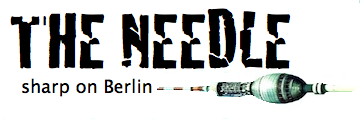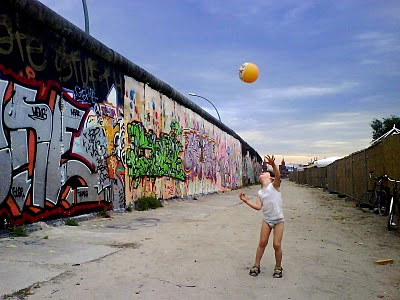What’s Changed in Berlin in a Decade? Ten Years of ‘Moving to Berlin’
Ten years ago The Needle published its first ‘Moving to Berlin’ guide, and it’s been updated every year since then.
Reading back to the first guide––oh boy!––how the city has changed!
The biggest changes aren’t hard to guess if you have lived in the city for a few years. The cost of housing will probably come first to mind.
The 2009 guide gave apartment hunters the following advice:
Property prices in Berlin are a very good deal:
-Mitte and Prenzlauer Berg: €8-10 / sq meter (€450-500 per month for 50 sq meters)
-Kreuzberg and Friedrichshain: €7 / sq meter (€350 per month for 50 sq meters)
-Neukölln: as low as €5 / sq meter (€250 per month for 50 sq meters)-To buy, costs are about €2200 / sq meter in Mitte and Prenzlauer Berg, €1800 / sq meter in Kreuzberg, cheaper in Friedrichshain, and closer to €1000 / square meter in Neukölln. It’s still possible then to buy an 80 sq meter apartment in Neukölln for €80 000.
You are probably shaking your head. Even year on year, Berlin has the world’s fastest growing property prices. The 2019 guide shows how rents in all these neighbourhoods have doubled since 2009. And the cost of buying an apartment has almost quadrupled. In 2019, Mitte’s cost to buy (average) is €7500 / sq meter and Kreuzberg’s €6000 / sq meter. Neukölln is five-times more expensive than a decade ago at €5000/ sq meter––more than twice what Mitte cost in 2009! In a time of low interest rates, buying an apartment a decade ago would have been one of the smartest things you ever did.
Speaking of Neukölln, neighbourhoods have changed a lot too. Neukölln was described in the 2009 guide as:
a working class and immigrant neighbourhood that is rapidly filling with young artists looking for cheap digs. The area between Hermannplatz and the canal has been absorbed into the hip of Kreuzberg. Some housing deals in this “Kreuzkölln” can be found, and there are lots of students here. The area South of Hermannplatz and to the East of it can be bleak, depressed in places. In others, there is the little Lebanon on Sonnenallee with good falafel and shisha, and some funky new youth cafés opening around S-Bahn Neukölln, and in the Weserstraße. The area around Richardplatz (Rixdorf) has village architecture and is full of immigrant families.
While, nowadays, “Neukölln is Hipsterland for the 20s-30s set. English and Spanish are often heard more often than German. The northern parts of Neukölln within the Ring already resemble what Prenzlauer Berg was like just a decade ago, just more international”.
Meanwhile, in 2009, Charlottenburg and the Old West was:
an expensive, Bourgeois, boring neighbourhood full of old people. Have you seen “City of Men”? Far far away from all the reasons one moves to Berlin… except to go bathing in the Schlachtensee.
I got some flak for this disparaging description back then. In the 2019 guide, I wouldn’t dream of it. The Old West neighbourhood gets the following treatment:
The rediscovery of the Old West is a phenomenon of the past couple of years. The pressure on housing farther East are making the West increasingly more popular with new Berliners. Who would have thought!?: Charlottenburg––and especially down Kantstraße––is finally cool.
Meanwhile, in 2009, Wedding was “a poor neighbourhood north of Mitte. Mostly Turkish-German families. Rather bleak architecturally”. It’s a place where no young arty person wanted to live. No-one could have imagined it would ever become so desirable. But in 2019, one reads:
Wedding, along with Moabit, is the new ‘it’ neighbourhood, in the throws of gentrification. Zitty (Berlin’s City Magazine) voted it the 7th best neighbourhood in Berlin in 2016. Wedding has become a place with an emerging arts scene…
Day-to-day life is also a lot more expensive. I remember the years of 50-something cent beers from Spätis and empty summer streets in Kreuzberg. I remember going out with ten euros in my pocket and coming home with change.
In 2009, the guide advised:
–For €15 you can have a great night out: drinking two bought beers in an industrial space with friends (€1), going for Falafel (€3), drinking a beer in a cool bar (€3), going to a great club (€5 at SO36 for example at the door, then €3 for a half litre of beautiful German Pilsner).
-You could on the other hand spend €75-150 for a great night out: aperitif at a terrace in Mitte (cocktail: €7), great seats at the opera or Berlin Philharmonic (€50; or else get cheap seats for €15), a great meal at slick Borchardt (three courses plus wine: €75; or just get the Wiener Schnitzel and a glass of wine for €25), slip home to change and then another drink at a cool bar (€3-7), then clubbing at Berghain (€12 entry, plus €3 per beer, €5-7 per cocktail).
I think it’s fair to say a lot of those prices are about a third higher. And I’m taking into account inflation of about 1.5% a year.
Back in 2009, the guide advised: “You can get along in Berlin without a lot of money. €800 / month for everything is about the minimum.”
Hmmm….wow.
Who would have thought it?
Meanwhile, there are the things that haven’t changed so much. A monthly ticket on the BVG cost €72 back then, so it’s only gone up about €1 a year in the last decade. Phone calls with a discounter SIM card cost 9 cents / minute back then too. McFit was €16,50 instead of €19,90. And one of the few things that is cheaper these days is public health care if you are freelancer (with the new law bringing the starting contributions under €200).
What do these changes in affordability tell you about the city?
Berlin was once “poor but sexy”. It’s not so poor anymore. In 2009, 14% of the city was unemployed (down from 19% in 2005). Nowadays, unemployment has halved to about 7,5%. Average income in Berlin was 1541 EUR/month net in 2009. Today, it’s about 2500 EUR/month net (4000 EUR/month brutto) depending on the source. People are richer in Berlin. But there are also a lot of richer people living alongside the poor––with an increasing gap in wealth. No wonder that protests against rising rents and gentrification have never been so intense as today.
Is Berlin still sexy? Is it over? It’s a matter of opinion, of course, but the city is getting busier, more international, more cosmopolitan, more of a European powerhouse. It feels more like what you would expect of the busy capital of Europe’s largest economy––getting closer to the way it was described as the epitome of a Großstadt in the 1920s. The population has increased by almost 400 000 since 2009. One in four Berliners doesn’t have a German passport and there are record numbers of internationals, also because of the 2015 refugee wave. I like that Berlin is increasingly multicultural, more of a metropolis, and has more big city buzz. I think this is sexy. But while Berlin is still less expensive than other metropolises, such as Paris (where housing prices are double Berlin’s), it can no longer be described as a ‘deal’. I know many people mourn the loss of Berlin’s protected Kleinstadt-as-capital feel, but there are advantages to the fascination and energy of a bigger city.
When the first published the guide in 2009, I included the following picture of a child playing along the remains of the Berlin Wall, at the back of the East Side Gallery. The child is now a young man in high school. The Strandbar where the photo was taken is now a place where luxury apartments have been built. But I do think the ball is still in the air.
You can read the Needle’s Moving to Berlin Guide here.


So how will the city look in ten years?
I remember from the Linie 1 Musical in the 80th that the rents are too high for a living. Neukölln will be like PBerg? I am longing for your predictions.
That’s a good question. For rentals, there’s a referendum to redistribute property out of the hands of large landlords. If a lot of property goes back into public hands, it could really change the direction of Berlin rents, and keep the city an affordable place. As for buying, if things continue on the same trajectory as now, then prices will only go up. I have no crystal ball: but I would think that every property in an old-world building (Altbau) in a desirable location (let’s say broadly within the S-Bahn ring) could rise to over 6000 EUR/m2. That’s what rental prices already are in the ten most central districts of Munich, and the prices are similar in central Hamburg, so I don’t see why the capital should be any different. Prices in Kreuzberg and Mitte are already past that level. So I would bet that Schoeneberg, Moabit, and Friedrichshain will be fast to catch up. I wouldn’t be surprised to see m2 prices in Neukölln reaching above 6000 EUR in only a couple years. Wedding would follow a couple of years later. And then, I’d be interested to know what happens in a place like Treptow. Again, I have no crystal ball…
I miss the beach bars along East Side Gallery as well as the low-priced and creative bars and cafes all over Berlin, I miss Tacheles and the time where I would walk in Mitte. But I do also see a lot of new opportunities coming up now with a lot more jobs in Berlin, and I am confident that the Berliners will find a very Berlin way to describe the city I love so much.